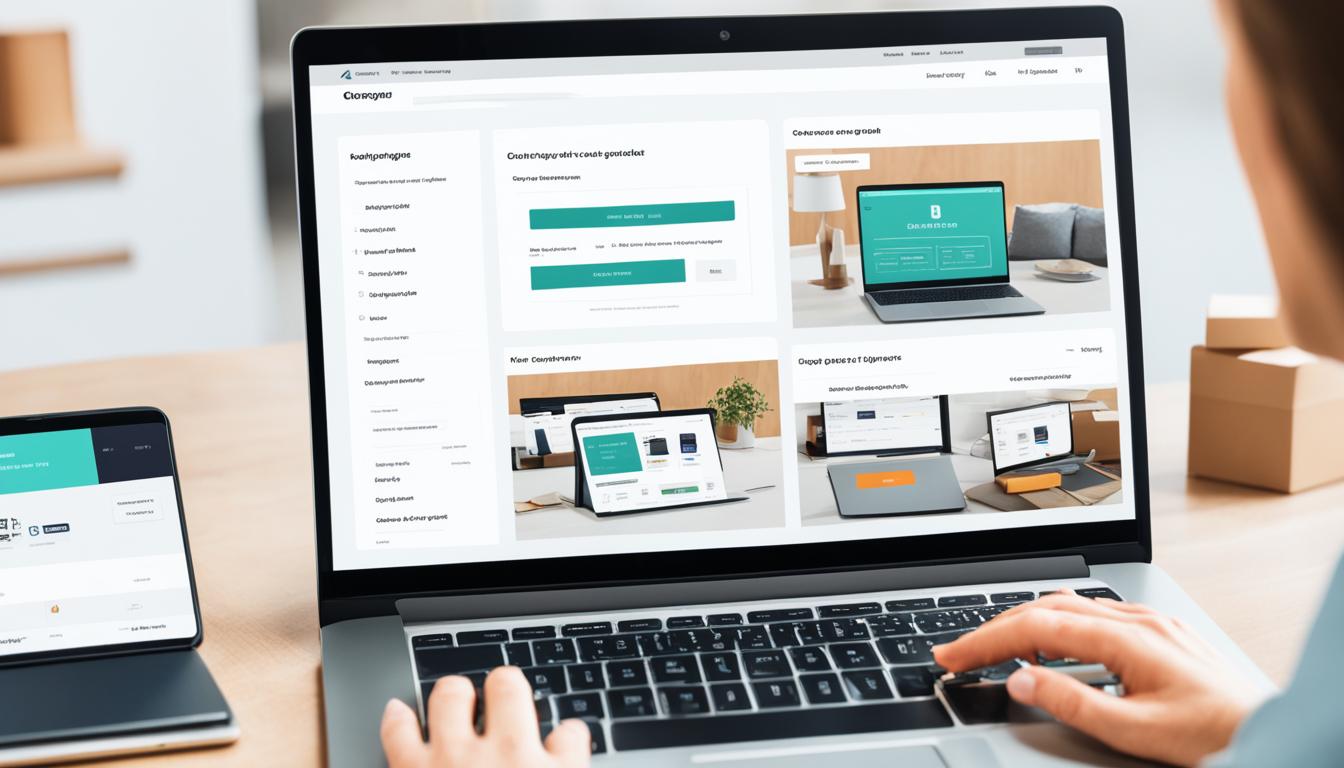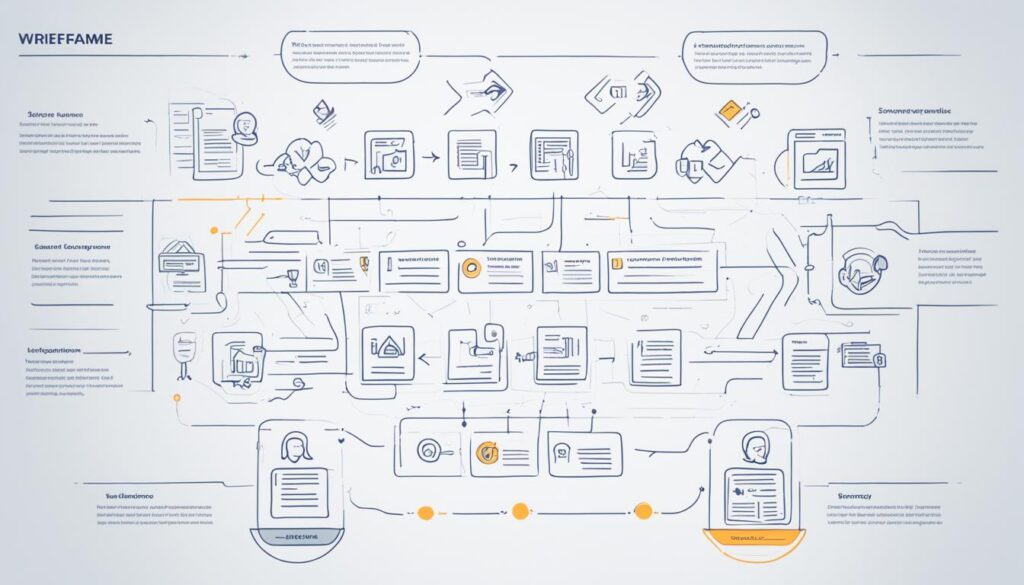Wireframing and Understand your User Journey is crucial

Table of Content
I sit at my desk looking at a blank page. It shows how important user-centric design is. We use wireframing and map user journeys. This helps us make designs that fit users perfectly.1
Wireframing is vital in UX design. It lets you see how your product will look, work, and feel.2But it’s more than just a sketch. It’s about making sure your design meets user needs and business goals.
User journey mapping is key too. It shows how users go through your product. It highlights their thoughts, feelings, and challenges. This insight is crucial for creating a product that deeply connects with users.1
Key Takeaways
- Wireframing lets us see how our product will work, making it a key step in UX design.
- User journey mapping tells us much about how users engage with our product and its impact.
- It’s crucial to design wireframes with both users and business goals in mind for success.
- Always keep improving with research, testing, and by using tools like Customer-Journey Wireframes.
- These tools can help make designing easier and team work more efficient.
At Defyn, users are our top priority. Tell us about your website challenges at hello@defyn.com.au. We believe in creating digital experiences that truly engage your audience.
Know Your Users and Goals
Before wireframing, let’s identify our users and their needs. We can research through interviews, surveys, or analytics to create detailed user personas.3 It’s key to remember that what users say may differ from what they actually do. Their actions might not match what they truly want.3
Understand Stated, Revealed and Actual User Preferences
It’s important to know our users deeply. Understanding their true needs and wants is vital to make a design that really connects with them.3 Deep user research lets us find out about their hidden needs and pain points. This knowledge helps us create designs that meet their real needs.
Define Clear Business Objectives
We must not only know our users but our business goals too. This could include wanting more sales, customer loyalty, or higher revenue.3 Setting goals with tools like SMART goals or OKRs can help. They focus our efforts on achieving important results for our business.
Balance User Needs with Business Goals
Create a wireframe that meets both user needs and business goals. It’s a fine balance that requires us to think strategically.3 This balance ensures we create something of value for both customers and our business.
Understanding users and business objectives deeply is crucial. It allows us to design solutions that benefit everyone. These efforts lead to a design that focuses on both user experience and business success.
Create User Journeys and Scenarios
User journeys and scenarios are like stories. They show how users go from A to B with your product to meet their needs.4 These tales cover where, what, why, and how users engage with your product. Tools such as user journey maps, storyboards, and flowcharts can bring these stories to life.4 Such methods help in understanding what your product needs. They also highlight areas for improvement.4
Creating user journeys and scenarios mirrors storytelling. It’s like crafting a ‘day in the life’ for your users, showing their use of your product from beginning to end.4 With these narratives, you can figure out essential features, foresee user issues, and discover opportunities to amaze them.4
| User Journeys and Scenarios | Benefits |
|---|---|
| Identify key features, functions, and content | Understand user needs and pain points5 |
| Visualize user experiences with the product4 | Optimize user experience (UX)5 |
| Pinpoint product requirements and opportunities | Include personas, scenarios, journey stages, actions, emotions, and more5 |
Through user journeys and scenarios, we dive deeper into how users think and feel about our products. This knowledge helps in designing products that focus more on the user and are therefore more successful.
Wireframe the Key Screens and Interactions
After mapping out user journeys and scenarios, it’s time to wireframe the main screens and interactions. This step involves sketching out design ideas with simple elements like shapes and text.2 You can create these wireframes with just a pen and paper, on a whiteboard, or with digital tools such as Balsamiq, Sketch, or Figma.2 This process helps test your concepts, share your vision with others, and improve your designs.2 By mapping user needs to business objectives through these wireframes, you set the foundation for a successful design. They act as a guide, focusing on usability and the overall user experience.
Low-fidelity wireframes are the first type you will create. They use simple shapes and basic text to show the layout. This step is key for focusing on the design without getting lost in details.6 Mid-fidelity wireframes come next. They give a clearer picture of the design with added details but still no images. This balances understanding the layout with avoiding distractions.6 Finally, high-fidelity wireframes are the most detailed. They include real images and content, perfect for the final design steps.6 Tools like Figma, Mockflow, Lucidchart, and Miro offer everything from basic wireframing to complex design collaboration.6
Align Wireframes with User Needs and Business Goals
When we design our screens and how they work, it’s key to think about what users need and what the company wants. Ways to do this include testing with users or getting feedback. This helps us see if our designs help the user. We should also think about the business side, using tools like a value proposition canvas. This helps ensure our designs meet business goals too.47
Gain Deep User Understanding
To make our designs fit what users and businesses need, we must really understand the users. We do this by studying them well and talking to everyone involved. It’s important to focus on what the users go through, find their problems, and fix them well.74
Harmonize User Solutions with Business Goals
We also need to make sure our designs help both users and the business, like increasing sales or keeping people interested. This process always needs to improve. We keep making our designs better based on what users and others tell us.7 This helps keep the design good for users and the business.4
Iteratively Refine and Validate Wireframes
As we go on, we don’t stop here. We always check and update our designs with users, looking at how well they work and fit with what the company wants. This continuous work is key to making a design that works well for everyone.47

Wireframing and Understand your User Journey is crucial
Starting with wireframing and understanding users is key to creating digital experiences people love. Wireframes show the look and function of the product2. User journey maps reveal how users feel and what they need from the product1. This approach helps designers align the product with what users want and what the business needs.
| Benefits of Wireframing | Wireframing Importance | Low-Fidelity vs. High-Fidelity Wireframing | Popular Wireframing Tools |
|---|---|---|---|
|
|
Customer Journey Wireframing Approach
SNK came up with a cool way to talk about user journeys. They call it Customer-Journey Wireframes. These wireframes mix key parts from task flows, wireframes, and high-res designs. This combo makes it simple and nice to share user stories.19
What is a Customer-Journey Wireframe?
A Customer-Journey Wireframe mixes the best from task flows, wireframes, and high-res designs. It’s a unique way to show the customer journey. This method is great for clear storytelling and making the customer’s experience better.1
Design Process for Customer-Journey Wireframes
The process starts by laying out the journey in a simple, step-by-step way. Then, it adds the basic look and feel without getting too detailed. Next, it picks key UI elements to show the design’s direction. Finally, standout design features are added. These steps make sure the wireframes look good and focus on users and business goals.91
Benefits of Customer-Journey Wireframes
Using Customer-Journey Wireframes makes designing faster and clearer. It’s a great way to keep the focus on what really matters in the design. By using this method, designers make solutions that are all about the user and create value for both the customer and the company.19

Importance of UX and User Journeys
UX is all about how we feel when we use a website.10 It tracks our thoughts and emotions while we’re online. A user journey is part of UX, showing the steps a user takes to finish a task.10 To do well, businesses must focus on both user experience and the journeys their users take.
Define UX and User Journeys
Imagine eating at a bad restaurant – you might complain and never go back. A bad user experience can lead to unhappy customers and bad reviews.11 However, a great UX based on careful research can boost your sales and brand. It makes customers want to come back for more.11
Impact on Business Success
Creating a journey map helps visualize how users interact with your product or service.12 People are more likely to remember bad experiences, so making online experiences better is crucial.12 A user journey map finds and fixes issues, making the brand more user-friendly. This process introduces new ways to make users happier.11 By mapping user journeys, businesses can closely connect with their audience. They offer a smoother, united user experience. This strengthens loyalty and keeps users engaged.11
User Research for Journey Mapping
To make a great user journey, first, we must learn about your users. We look into what they need and what makes them struggle.1 Using tools like Google Analytics and Hotjar, we see where users click and what they read.10 Testing with real people on UserTesting also helps understand your site’s usability.9 Checking out what competitors do shows us new ideas and how to get better.
Analytics and User Behavior Data
Tools such as Google Analytics and Hotjar are gold mines for insights.1 They show us how users move around your website. This helps us find what’s not working and what could be better.10 Knowing how users behave is key to crafting the journey they want and need.
User Testing and Feedback Tools
Getting direct feedback from users is crucial for a great user experience.1 Resources like UserTesting let us hear from actual users. They pinpoint usability issues and suggest improvements.9 This info guides us in designing a user journey that’s smoother and more satisfying.
Competitor Analysis
Studying your competitors’ user journeys gives us fresh ideas and shows where to improve.9 It helps us find what works well, what frustrates users, and how you can stand out.1 Combining this knowledge with our research, we can craft a unique, top-tier user journey.
Visualize and Iterate User Journeys
Understanding your users and their journey is key. Once you know this, start visualizing and improving the13 user journey. Use user journey maps to show the steps they take on your website. Creating user personas also helps. They make the journey design more focused on real users.13
User Journey Maps
User journey maps are great for seeing and improving the13 user experience. They show each stage and how customers interact.13 By seeing the journey, you can spot where it’s hard and make it better. You can also find ways to make it smooth and fun.
User Personas
Making13 user personas is essential for good user experiences. These personas are like profiles of your users. They tell you what your users want, do, and what bothers them. This info helps you tailor your13 designs to meet their needs.
Wireframes for Journey Testing
After figuring out the user journey and personas, start13 wireframing. This is where you sketch out the main screens and how they work. It’s a way to test if your design fits what users need and what the business wants.13 Doing this early lets you fix any issues before the final design.
Continuous Improvement Cycle
The job continues even after your website or product is live. You have to keep making it better. User needs change all the time.13 So, always go back to research and tests. Use what you learn to tweak your13 designs and user journeys.13 This way, you keep up with what users want and what your business needs.
| Metric | Value |
|---|---|
| Companies that surpassed revenue goals with a well-documented customer journey mapping process | 1479% |
| Customer journey maps created with UXPressia that include a layer for the average customer perspective, needs, and goals | 1497% |
| Businesses that experienced increased customer satisfaction using customer journey mapping | 1480% |
| Average number of times a customer interacts with a business before making a purchase | 1412 |
To make great13 user experiences, focus on user journeys. Use13 user journey maps, create13 user personas, and test with13 wireframes. Also, keep making it better with feedback and checks.13 Remember, improving never stops. Make sure you keep up with your users’ changing wants and needs.
Conclusion
Wireframing and understanding the user journey are key in creating user-friendly digital experiences.1 By researching our users and their needs alongside our business aims, we design scenarios. These scenarios match user needs with our business objectives.15
Creating wireframes based on these user journeys acts as a design blueprint. It guarantees a smooth user experience and usability.16
Connecting wireframes with user needs and business goals through tests and tweaking is vital. It ensures your solution meets users’ expectations and boosts business success.15 Using tools like Customer-Journey Wireframes can make this process smoother. It helps in clear communication among all involved parties.1
Ultimately, focusing on UX and user journeys is crucial. It helps in making digital products that please customers and meet business aims.15
Need help with your website? Send us an email at hello@defyn.com.au.
FAQ
What is the importance of wireframing and understanding user journeys in crafting digital experiences?
How do we align wireframes with both user needs and business goals?
What is a Customer-Journey Wireframe and how does it benefit the design process?
Why is it important to understand the difference between stated, revealed, and actual user preferences?
How can analytics and user testing tools help in understanding user journeys and designing effective wireframes?
What is the importance of continuously improving user journeys and wireframes based on user feedback and changing user behavior?
Source Links
- https://www.visily.ai/blog/user-journey-mapping/
- https://www.experienceux.co.uk/faqs/what-is-wireframing/
- https://www.experienceux.co.uk/faqs/what-are-user-journeys/
- https://www.linkedin.com/advice/0/how-can-you-balance-user-needs-business-goals-when-y8cne
- https://www.coursera.org/articles/creating-user-journey-maps-a-guide
- https://www.interaction-design.org/literature/topics/wireframing
- https://mockflow.com/blog/Essential-Steps-to-Take-Before-Wireframing
- https://blog.searchmyexpert.com/wireframing-ux-design/
- https://www.interaction-design.org/literature/topics/customer-journey-map
- https://www.nngroup.com/articles/user-journeys-vs-user-flows/
- https://www.qualtrics.com/experience-management/customer/ux-journey-map/
- https://www.linkedin.com/pulse/importance-user-journey-mapping-aufaitux-z7nzc
- https://www.uxpin.com/studio/blog/how-to-create-ux-customer-journey/
- https://leadadvisors.com/blog/user-journey-mapping-a-guide-to-optimize-user-experience/
- https://www.gleek.io/blog/user-journey-design
- https://bootcamp.uxdesign.cc/wireframes-a-crucial-step-in-the-ux-design-journey-db5df6a04068










